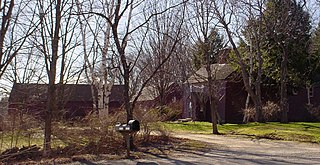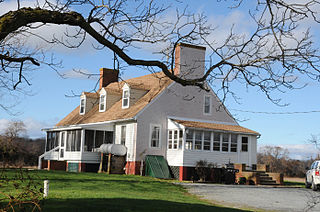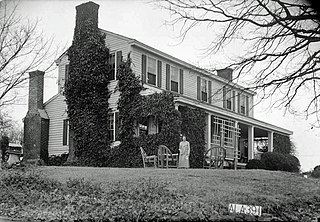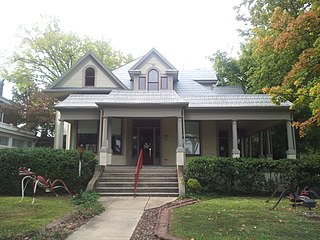
Ozark is a city in and the county seat of Dale County, Alabama. As of the 2010 census, the population of the city was 14,907.

Carlos Avery House is a historic house in the Pittsfield Township, Ohio.

The John Sedgley Homestead is a historic homestead property at Scituate and Chases Pond Road in the York Corner area of York, Maine. Its oldest structure built in the late First Period, probably c. 1715, it is the oldest homestead in the State of Maine that is still in its original setting. Historically the homestead included a cape, farm home, carriage house, stables building, two outbuildings, and a large land holding, all of which is still existing today. The property was listed on the National Register of Historic Places in 1976.

Bachelor's Hope is a historic house in Centreville, Maryland. Built between 1798 and 1815, it was added to the National Register of Historic Places in 1984.

Hawthorne, also known as the Browder Place, is a historic Italianate plantation house and historic district in Prairieville, Alabama, USA. This area of Hale County was included in Marengo County before the creation of Hale in 1867. Hawthorne is included in the Plantation Houses of the Alabama Canebrake and Their Associated Outbuildings Multiple Property Submission. It was added to the National Register of Historic Places on July 7, 1994, due to its architectural significance.

The Walden Jam-e-Masjid, formerly the Historic Walden United Methodist Church, is a mosque located in Walden, New York, United States. It was desanctified in 2013 and sold by the congregation the following year. The building was repurposed as a mosque by a Muslim congregation after being purchased in 2022.

The Samuel W. Temple House is a residential structure located at 115 West Shawnee Street, at the junction with North Pearl Street, in the city of Tecumseh in Lenawee County, Michigan in the United States. It was designated as a Michigan Historic Site and added to the National Register of Historic Places on August 13, 1986.

Mount Sterling Methodist Church is a historic Methodist church building near the junction of Choctaw County Road 43 and Choctaw County Road 27 in the rural community of Mount Sterling, Alabama, United States. It is an almost unaltered example of the simple, Greek Revival style popular for rural churches in the mid-19th century. It was added to the National Register of Historic Places on May 8, 1986.
Old Town, also known as the Thomas Brown House, is a house in Franklin, Tennessee, United States, at the Old Town Archeological Site that was built by Thomas Brown starting in 1846. It is a two-story frame structure built on an "I-House" plan, an example of vernacular architecture showing Greek Revival influences. The Thomas Brown House is among the best two-story vernacular I-house examples in the county.

The James Greer Bankhead House, also known simply as the Greer Bankhead House and Forest Home, is a historic house in Sulligent, Alabama. It was added to the National Register of Historic Places on February 13, 1975. It is the only site listed on the National Register in Lamar County.

Oakey Streak Methodist Episcopal Church is a historic church in Butler County, Alabama, United States. The congregation was organized in 1831, and the land where the current church sits was given to the church in 1851. A log building was erected soon after, replaced by the current frame structure around the 1880s. The church was expanded and a bell tower was added in 1903. Along with the adjacent Masonic Lodge, which was demolished in the 1940s, the church was the social center of the area.

The McCartney–Bone House is a historic residence near Maysville in Madison County, Alabama. The house was built in 1826 by James McCartney, who came to Madison County in 1810. McCartney held several public offices in the county, including Justice of the Peace, Tax Assessor and Collector, and County Commissioner. He was also a member of the Flint River Navigation Company, which sought to improve transportation along the Flint River to the Tennessee River, making it easier to get goods from northeastern Madison County to market. McCartney died in 1831, and his wife, Martha, remarried twice, the second time to Reverend Matthew H. Bone. After Martha's death in 1885, the house remained in the family until 1955.

The Jude–Crutcher House is a historic plantation house in Huntsville, Alabama. The house was built circa 1812 on land deeded that year to Samuel Echols. Echols sold 54 acres and the house to George Jude, Sr., in 1817. Jude died two years later, leaving the land to his son, George Jr. The younger Jude eventually acquired 800 acres and owned 31 slaves. Upon his death in 1873, the land stayed in the family until 1883. In 1906 David Crutcher, who had been born a slave on an adjacent plantation in 1851, purchased the house and 154 acres along with two other African-American men. The Crutchers operated a successful farm on their portion of the land, which was an extension farm for Alabama A&M University until the 1940s. Only 7% of African-American farmers in Madison County in 1910 owned their own farms. David died in 1924, and his wife, Lucy, died in 1943, although the house and land is still in the family.

The Ford–Countess House is a historic residence near Huntsville in Madison County, Alabama. Hezekiah Ford came to Madison County from Cumberland County, Virginia, in 1813, and began purchasing land on which to build a cotton plantation. He acquired the land on which the house stands in 1820, and built the two-story, brick I-house soon after. Ford died in 1839, and the land was owned by his wife, Nancy, until her death in 1844. Hezekiah's brother, John, then assumed ownership, and the plantation stayed in his family until 1904. It reached a peak of 280 acres, and the family owned 69 slaves in 1860. James W. Burcum owned the property from 1904 until 1911, when it was sold to Stephen H. Countess of Tuscaloosa. The Countess family still owns and farms the land, although the house has not been occupied since 1995.

The Wilson Park Houses are a group of three historic homes in Florence, Alabama. Built as upper-class residences between 1890 and 1918, the houses are adjacent to Wilson Park, laid out as a public space upon the city's founding and later renamed for President Woodrow Wilson. Two of the houses came to be owned by Hiram Kennedy Douglass, who upon his death in 1975 willed the houses to an organization willing to maintain them for the public. The houses are now owned by the city and contain the Kennedy-Douglass Center for the Arts. The houses were listed on the National Register of Historic Places in 1979.

The Oaks is a historic residence near Tuscumbia in Colbert County, Alabama, United States. Ricks came to North Alabama from Halifax, North Carolina, in the early 1820s. He acquired a large plantation which he sold in 1826 and purchased nearby land, which was worked by the forced labour of enslaved people who he had brought with him. A log house had been built on the new property circa 1818, and Ricks built a new, larger house connected to it which was completed in 1832. The house remained in the family until 1966, and is still in use as a private residence.

Preuit Oaks is a historic plantation house near Leighton in Colbert County, Alabama, United States. The house was built in 1847 by Dr. John S. Napier, on land originally owned by his father-in-law. The house and land were sold in 1851 to W. Richard Preuit, who developed the property into a large cotton plantation using the forced labour of enslaved people. At its peak in 1860, the plantation covered 1,500 acres ; following the Civil War, its productivity declined, and Preuit's holdings had depleted to only 400 acres upon his death in 1882. The house has remained in the family since.

The Ernest Edward Greene House is a historic residence in Cullman, Alabama, United States. The house was built in 1913 by Ernest Edward Greene, the superintendent of Southern Cotton Oil Company. After Greene's death in 1922, the house was passed on to several more owners, including John George Luyben, Sr., who lived in the house for 34 years.
The Larsson–Noak Historic District encompasses a collection of buildings constructed by Swedish immigrants to northern Maine between about 1888 and 1930. The district is focused on a cluster of four buildings on Station Road, northeast of the center of New Sweden, Maine. Notable among these is the c. 1888 Larsson-Ostlund House, which is the only known two-story log house built using Swedish construction techniques in the state. Across the street is the c. 1900 Noak Blacksmith Shop, a virtually unaltered building housing original equipment. The district was listed on the National Register of Historic Places in 1989.

The A. J. and Emma E. Thomas Coley House is a historic residence in Alexander City, Alabama. The house was built by A. J. Coley, a physician who was born near Alex City in 1858. After studying medicine in Philadelphia and New York City, Coley returned to Alabama and married Emma E. Thomas. In 1895, the couple built their house in Queen Anne style, a popular style for houses in the late 19th century. Coley served as mayor of Alex City from 1902 to 1903. In 1909 Coley sold the house to another physician, James Adrian Googan, who used it as his residence and an infirmary. Except during World War II, when it was subdivided into apartments, it has been maintained as a single-family home since Googan's death in 1920.




















